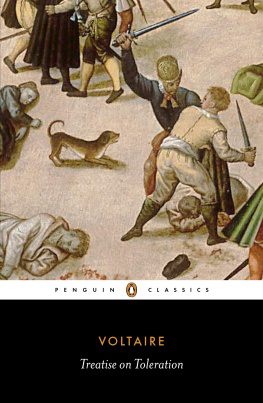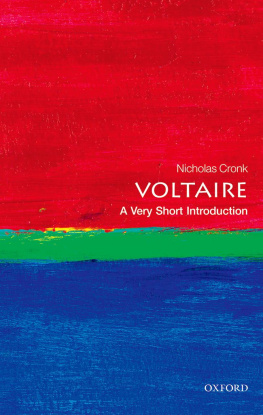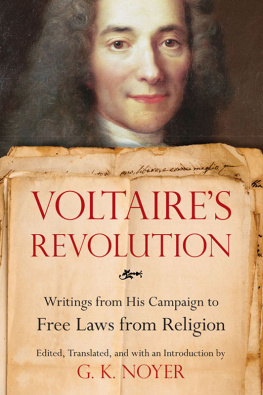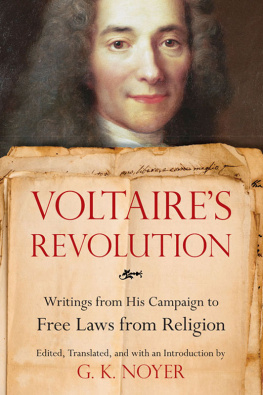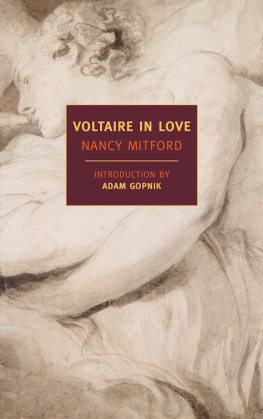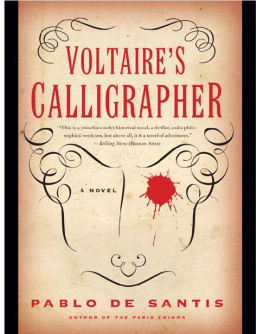VOLTAIRE

IAN DAVIDSON

PEGASUS BOOKS
NEW YORK
CONTENTS
To Jennifer

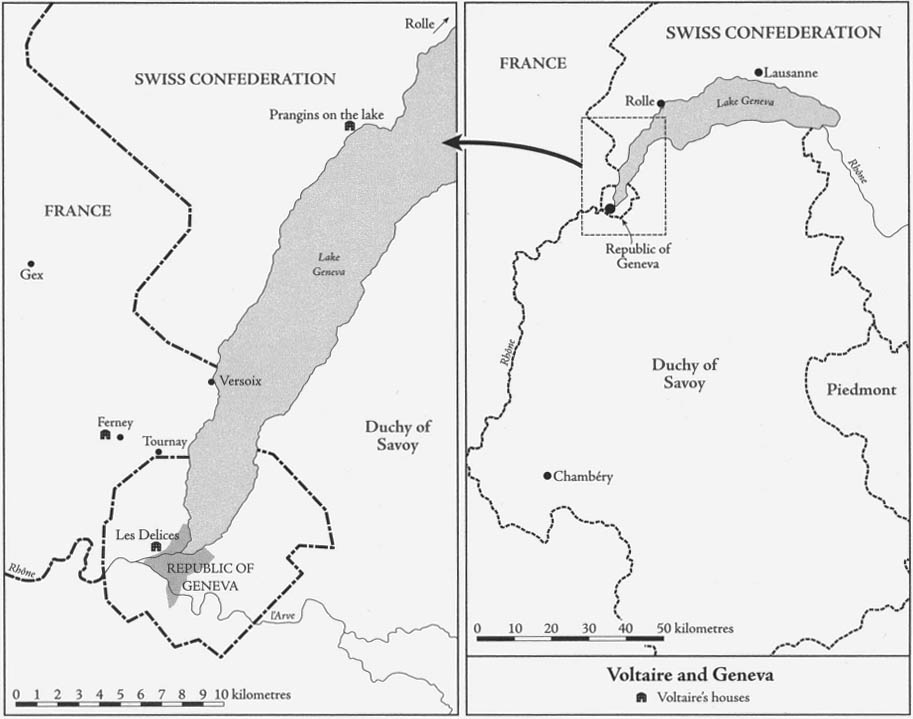
NOTE TO THE READER
Francs and livres; pounds, shillings and pence; feet and inches
Under the ancien rgime the structure of the French currency was very similar, for historical reasons, to that of Britain before decimalisation in 1971. The principal currency unit in France was the livre (meaning pound), and its symbol was , a stylised form of the letter L; the franc was an equivalent term, meaning the same as livre. There were 20 sous to each livre, and 12 deniers to each sou (or sol). So the symbols for the main units of the French currency under the ancien rgime were s. d., just as they were in England. The French currency also included the louis (a gold coin worth 24), the cu (a silver coin worth 6) and the petit cu (worth 3).
In this book, unless otherwise specified, the symbol should be taken to mean livre or franc.
There were analogous similarities of structure in French and English units of measurement: in France there were 12 pouces to the pied, just as there were 12 inches to the foot. But the French units were larger than the English: the pouce was 2.707 cm, and the pied was 32.5 cm, whereas the inch was 2.54 cm, and the foot 30.48 cm.
I have not attempted to make any direct translations between money values in the eighteenth century and money values today, because the attempt is hopeless: if you were to compare the price of bread then with the price of bread today, you would get one rate, but if you were to compare the prices of houses, you would get another. Theodore Besterman points out that commodity prices more than doubled between the death of Louis XIV and the French Revolution, whereas wages increased by only about 20 per cent, and yet he estimated in his biography Voltaire (1969) that the franc or livre of Voltaires day was roughly equivalent to a US dollar. This kind of exchange rate conversion implies a precision that is spurious and largely misleading. Moreover, Bester-mans rate seems to me wildly out of kilter; if one had to choose a single exchange rate, it would probably have to be closer to 1 = $10.
In the last resort we probably cannot get a useful answer to the question What would 50,000 livres be worth today?, because it is the wrong question. What we should be asking instead is: What would 50,000 livres have meant then? Following this line of thought, it has been argued that in the eighteenth century a person with an annual income of 15,000 livres or more could be described as wealthy, and a person with an income of 30,000 livres or more could be described as extremely wealthy. If this benchmark is even roughly valid, it implies that when Voltaire became wealthy, after 1729, he became very, very, very wealthy.
Life expectancy
On average, life expectancy was much shorter in France in the eighteenth century than it is today; but only on average. Many died in infancy, and many died of disease; but those who survived the dangers of birth and sickness and who were spared the even greater dangers attendant on poverty and malnutrition, could live long lives, comparable to those of today.
Peri-natal mortality was very high, perhaps about 50 per cent. Voltaires mother, Marie-Marguerite Daumart, had five children, two of whom died almost immediately. Similarly, milie du Chtelet (Voltaires mistress and the love of his life) had three legitimate children by her husband. The first two survived to adulthood; the third died suddenly, in infancy, only sixteen months old. Fifteen years later, in 1749, she had a fourth child, by the Marquis de Saint-Lambert; she and the child, a daughter, both died in childbirth.
Death was also common in early adulthood. Voltaires mother died in 1701, when she was only forty-one, and Voltaire was seven; his sister, Marguerite-Catherine, died in 1726, when she was only thirty-nine.
Hygiene and medicine were both quite primitive, and one of the major killers was smallpox. Voltaire caught the disease in a major epidemic in 1723 and survived, but his close friend Nicolas de La Falure de Gnonville died of it. An even closer friend, Jean-Ren de Longueil, marquis de Maisons, also caught the disease at the same time as Voltaire; in fact, Voltaire caught it while staying in Maisonss house. Maisons survived this epidemic but was infected again eight years later, in 1731, and this time he died of it.
But the survivors could live long lives. The table below shows that many of Voltaires most prominent contemporaries, and many of his most frequent correspondents, lived into their sixties, seventies, eighties, or even nineties. The most signal exception was tienne-Nol Dami-laville, who died of throat cancer, aged forty-five.
Dates | Age |
Andr-Hercule, Cardinal de Fleury | 16531743 | |
Prosper Jolyot Crbillon | 16741762 | |
Voltaire | 16941778 | |
Ren-Louis de Voyer, marquis d Argenson | 16941757 | |
Mme de Graffigny | 16951758 | |
Marc-Pierre de Voyer, comte d Argenson | 16961764 | |
Nicolas-Claude Thieriot | 16961772 | |
Mme du Deffand | 16971780 | |
Pierre Louis Moreau de Maupertuis | 16981759 | |
Duc de Richelieu | 16991788 | |
Charles-Augustin, comte d Argental | 17001788 | |
Jean-Robert Tronchin | 17021788 | |
Franois Tronchin | 17041798 | |
Jean-Frdric Phlypeaux, comte de Maurepas | 17011781 | |
Thodore Tronchin | 17091781 | |
Louis XV | 17101774 | |
Frederick the Great | 17121786 | |
Jean-Jacques Rousseau | 17121778 | |
Denis Diderot | 17131784 | |
Jean-Franois, marquis de Saint-Lambert | 17161803 | |
Jean Le Rond d Alembert | 17171783 | |
tienne-Franois, duc de Choiseul | 17191785 | |
tienne-Nol Damilaville | 17231768 | |
Footnotes and endnotes
I have tried to keep footnotes to a minimum, but occasionally there is a gobbet of information that seems to me interesting and relevant, and worth including, even though it may not fit naturally into the body of the text.
There are many endnotes, but their sole function is to provide a source or citation for information in the body of the text, usually in the form of a quotation from a letter or other document. In the ordinary course of events, therefore, the general reader can simply ignore these endnotes.
PROLOGUE
Next page



